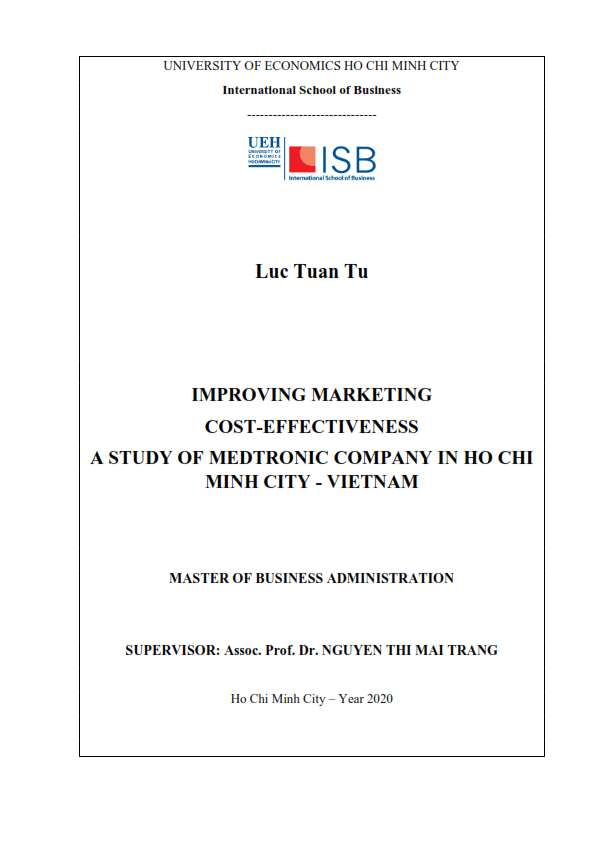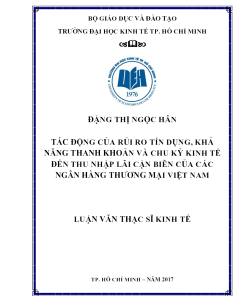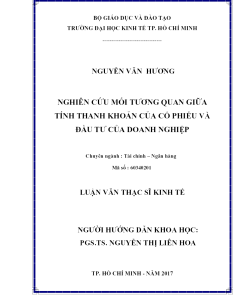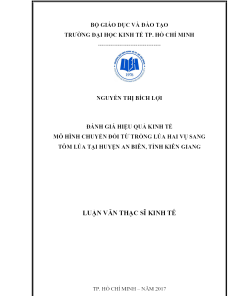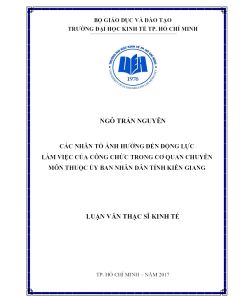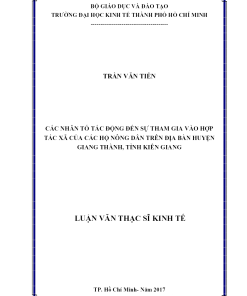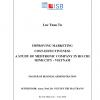- Giảm 10% phí tải tài liệu khi like và share website
- Tặng 1 bộ slide thuyết trình khi tải tài liệu
- Giảm 5% dịch vụ viết thuê luận văn thạc sĩ của Luận Văn A-Z
- Giảm 2% dịch vụ viết thuê luận án tiến sĩ của Luận Văn A-Z
Improving marketing cost-effectiveness a study of Medtronic Company in Ho Chi Minh City – Vietnam
50.000 VNĐ
Download Master Thesis: Improving marketing cost-effectiveness a study of Medtronic Company in Ho Chi Minh City – Vietnam
Download Master Thesis: Improving marketing cost-effectiveness a study of Medtronic Company in Ho Chi Minh City – Vietnam
Recently, the profit and loss of Medtronic has experienced a decrease versus its target. This circumstance is mostly impacted by increased number and amount of marketing activites. The main problems belong to the low efficiency of current marketing activities, reflecting through the low number of customer coverage while the spent marketing budget exceed it limit. In order to discover the issue that Medtronic facing with, meeting with two sales managers of the Business Unit as well as relevant sales representative has been implemented Through interviewing relevent subjest, using data provided by the company and using related theory, main problem was identified as low-cost effectiveness of marketing activities.
Towards main problem, three potential causes have been found are Lack or Low frequency of following up activities, Low competencies of sales team in order to cascade the impacts of the marketing events or Focus on wrong types of promotion activities. After analysis, main cause that chosen to solve is Focus on wrong types of promotion activities. This study will focus on solutions to address the cause in order to help the company to improve their Profits and Loss.
Keywords: Marketing, Cost effectiveness, Marketing cost
Recently, the profit and loss of Medtronic has experienced a decrease versus its target. This circumstance is mostly impacted by increased number and amount of marketing activites. The main problems belong to the low efficiency of current marketing activities, reflecting through the low number of customer coverage while the spent marketing budget exceed it limit. In order to discover the issue that Medtronic facing with, meeting with two sales managers of the Business Unit as well as relevant sales representative has been implemented
Through interviewing relevent subjest, using data provided by the company and using related theory, main problem was identified as low-cost effectiveness of marketing activities . Towards main problem, three potential causes have been found are Lack or Low frequency of following up activities, Low competencies of sales team in order to cascade the impacts of the marketing events or Focus on wrong types of promotion activities. After analysis, main cause that chosen to solve is Focus on wrong types of promotion activities. This study will focus on solutions to address the cause in order to help the company to improve their Profits and Loss.
ACKNOWLEDGMENT
Without the encouragement, guidance and support of Prof. Nguyen Thi Mai Trang and other teachers, the entire master-level project would not be possible. I would like to send my appreciation to my advisors. It has been a pleasure working with you on this project.
I would like to thank my friends and family for greatly supporting me while I was working on my research. Your Patience, understanding and respect were greatly appreciated.
TABLE OF CONTENTS
1. INTRODUCTION ……………………………………………………………………………………….1
1.1. GLOBAL MEDTRONIC CORPORATION ……………………………………………..1
1.2. VIETNAMESE MEDTRONIC CORPORATION ……………………………………..2
1.3. PINNACLE HEALTH EQUIPMENT CORPORATION…………………………….3
2. SYMPTOMS ………………………………………………………………………………………………4
3. PROBLEM IDENTIFICATION ……………………………………………………………………5
3.1. POTENTIAL PROBLEMS……………………………………………………………………..5
3.1.1 OVER-FOCUS ON LONG-TERM ACTIVITIES ………………………………..8
3.1.2 NOT SATISFY THE CUSTOMERS ACADEMIC REQUIREMENTS. …9
3.1.3 INSUFFICIENT KEY HOSPITAL MANAGEMENT ………………………..10
3.1.4 LOW COST-EFFECTIVENESS OF REGULAR MARKETING ACTIVITIES ………………………………………………………………………………………….12
3.2. PROBLEM VALIDATION …………………………………………………………………..15
4. POTENTIAL CAUSES ………………………………………………………………………………17
4.1. SALES REPRESENTATIVES LOW COMPETENCIES, UNABLE TO CASCADE THE IMPACTS OF EVENTS ……………………………………………………….18
4.1.1. TRAINING ARE NOT PRACTICAL …………………………………………………18
4.1.2. LACK OF CONTENT-CASCADING MATERIALS ……………………………19
4.2. LACK OR LOW FREQUENCY OF FOLLOWING ACTIVITIES –
INSUFFICIENT SALES REPS TO COVER …………………………………………………….21
4.3. FOCUS ON WRONG TYPES OF PROMOTIONAL ACTIVITIES………………22
4.3.1. FOCUS ON WRONG CUSTOMER SEGMENTATION ………………………22
4.3.2 NOT CLEAR INTERPRETATION ABOUT CUSTOMERS INSIGHTS…24
4.4. CAUSE VALIDATION …………………………………………………………………………..25
5. ALTERNATIVE SOLUTIONS …………………………………………………………………..26
5.1 ALTERNATIVE SOLUTION 1: RE-ALLOCATE EXPENDITURE TO OTHER
CUSTOMERS’ GROUP BY DIFFERENT APPROACH …………………………………..26
5.2 ALTERNATIVE SOLUTION 2: CONDUCT A SURVEY WITH DOCTORS TO UNDERSTAND DEEPLY CUSTOMERS’ INSIGHTS …………………………………….28
5.3 SOLUTION JUSTIFICATION ………………………………………………………………….29
6. CHANGE PLAN DESIGN………………………………………………………………………….31
6.1 OBJECTIVES ……………………………………………………………………………………..31
6.2 TARGETED OUTCOMES……………………………………………………………………31
6.3 ACTION PLAN IMPLEMENTATION…………………………………………………..31
7. CONCLUSION………………………………………………………………………………………….34
8. SUPPORTING INFORMATION…………………………………………………………………35
8.1 METHODOLOGY ………………………………………………………………………………35
8.2. INTERVIEW GUIDE …………………………………………………………………………..35
8.3 TRANSCRIPTS …………………………………………………………………………………..37
REFERENCES ………………………………………………………………………………………………..45
ABBREVIATION
APV Aortic, Peripheral and Venous CRHF Cardiac Rhythm and Heart Failure CS Cardiac Surgery
CVG Cardiac Vascular Group
EBIT Earning before Interest and Tax
FY Fiscal Year
HCP Healthcare Professionals KOL Key Opinion Leaders KPIs Key performance index
MITG Minimally Invasive Therapies Group MedEVAR Medtronic Endovascular Aneurysm Repair MedTEVAR Medtronic Thoracic Endovascular Aneurysm Repair PnL Profits and Loss
Q3 Quarter 3
RTD Round Table Discussion RTG Restorative Therapies Group T&E Training & Education
YTD Year to Date
LIST OF TABLES
Table 1: APV Profit & Loss (PnL) – Actual vs Target
Table 2: APV Profit & Loss (PnL) – Gap Table 3: APV FY20 P&L – Marketing report Table 4: Pinnacle Performance Report
Table 5: Quota Tender Report
Table 6: Financial Report – Spent Budget YTD Q3 FY20
Table 7. Training programs in 2019
Table 8. Quantity of customers and KOLs by portfolio Table 9: Quantity of engaged implanters by sales rep Table 10. Cost & benefits for alternative solution 1
Table 11. Cost & benefits for alternative solution 2
Table 12. Action plan (Author synthesis)
Table 13. Detailed description & objectives for specific tasks
LIST OF FIGURES
Figure 1: APV Organization Structure Figure 2: Pinnacle Organization Structure Figure 3: Training & Education Survey Report Figure 4: Cause-and-Effect map
Figure 5. Fish bone diagram of main problems and potential causes
Figure 6. Medtronic marketing materials
Figure 7. Cause-and-Effect map
Figure 8. Gantt-chart for action plan (Author synthesis)
1. INTRODUCTION
1.1. Global Medtronic Corporation
Medtronic PLC is a medical device company that generates the majority of its sales and profits from the U.S. healthcare system but is headquartered in the Republic of Ireland for tax purposes. Medtronic has an operational and executive headquarters in Fridley, Minnesota in the U.S. In 2015, Medtronic acquired Irish–tax registered Covidien (a U.S. tax inversion to Ireland from 2007), in the largest U.S. corporate tax inversion in history, which enabled Medtronic to move its legal registration from the U.S. to Ireland. Medtronic operates in 140 countries and employs over 86,000 people.
Medtronic was founded in 1949 in Minneapolis by Earl Bakken and his brother-in- law, Palmer Hermundslie, as a medical equipment repair shop. Through his repair business, Bakken came to know C. Walton Lillehei, a doctor of heart surgery at the University of Minnesota Medical School. The deficiencies of the pacemakers of the day were made painfully obvious following a power outage over Halloween in 1957, which affected large sections of Minnesota and western Wisconsin. A pacemaker- dependent pediatric patient of Lillehei died because of the blackout. The next day, Lillehei spoke with Bakken about developing some form of battery-powered pacemaker. Bakken modified a design for a transistorized metronome and created the first battery-powered external artificial pacemaker.
The company expanded through the 1950s, selling equipment built by other companies but also developing custom-made devices. Bakken built a small pacemaker that could be strapped to the body and powered by batteries. Work in the new field later produced an implanTable pacemaker in 1960. The company-built headquarters in the Minneapolis suburb of St. Anthony, Minnesota, in 1960 and the company moved to Fridley in the 1970s. Medtronic’s main competitors in the cardiac rhythm field include Boston Scientific and St. Jude Medical. In 1998, Medtronic acquired Physio-Control for $538 million.
According to a press release, the fiscal year 2019 revenue increased by 2% to $30.557 billion. The net earnings in the fiscal year were $4.631 billion or $3.41 per diluted
share. The non-generally accepted accounting principles (non-GAAP) earnings were
1
$7.089 billion or $5.22 in diluted earnings per share. The cash flow from operations was $7.007 billion. The free cash flow was $5.873 billion compared with $3.616 billion from the year prior, a 62% increase. And Medtronic, currently, is the largest Medical Device Company in the world.
1.2. Vietnamese Medtronic Corporation
Vietnamese Medtronic Corporation was established in 2016 and a subsidy of Global Medtronic. Like global company, Vietnamese Medtronic Corporation focus on 4 therapeutic Areas: Cardiovascular Group (CVG), Diabetes, Restorative Therapies Group (RTG) and Minimally Invasive Therapies Group (MITG). In each Group, it will be divided into small sub-groups based on Therapeutic Treatment. In CVG, Medtronic has 4 sub-groups as: Aortic, Peripheral & Venous (APV), Cardiac Rhythm and Heart Failure (CRHF), Cardiac Surgery (CS) and Coronary In this thesis, we only focus on Aortic, Peripheral & Venous Group (APV).
Figure 1: APV Organization Structure
(Source: Medtronic internal structure) For the current group, as above figure, Medtronic has 12 salespeople, including 02 sales managers and 01 national sales manager (Mr. Jason Dang). Total other 9 sales representative will cover national wide but mainly focus on Hanoi, Ho Chi Minh, Da
Nang and Can Tho.
2
1.3. Pinnacle Health Equipment Corporation
According to Pharmaceutical & Medical Device Regulation, a foreign company is not allowed to join in Supply & Distributing sectors in Pharmaceutical Industry. Only a Vietnamese Corporation with 100% Vietnamese Capital can participate and conduct customer’s selling. Therefore, the potential market for Vietnamese Distributor is annually growing.
Pinnacle Health Equipment Corporation is a young distributor established in 2013 and work in pharmaceuticals and medical device. Although the time length of establishment has been a short time but the leadership teams has had over 20 years of experience in Pharmaceutical Business Operations. Pinnacle Strategy for 2020-2025 and the vision to 2030 is to continue to develop as a distributor for multi-national companies and develop on two areas: Trading and Services (To supply and distribute high-quality products with reasonable price to all Vietnamese Customers) and Imports
& Exports (Exclusive import and distribution of World-class medical equipment and
Supplies)
Figure 2: Pinnacle Organization Structure
(Source: Pinnacle internal structure) For the collaboration with Medtronic Vietnam, currently, Pinnacle is the distributors dedicated to managing the Medical Device Business in the Middle (18 Provinces) & The South (17 Provinces) of Vietnam. The total workforce is 13 labors which sales
team have 8 staff, focusing mainly in the South of Vietnam
3
2. SYMPTOMS
To explore the possibilities of this FPS project. We conduct Intake and External exploration. Base on theory, the intake meeting needs to be prepared by a comprehensive external exploration. According to the internal data, the total target for this Fiscal Year (FY) 2020 is 4.3 MUSD, Growth rate at 7.4% and the Profit and Loss (PnL) or Earnings Before Interest and Tax (EBIT) is 2.2MUSD. The objectives from the company will have two Key Performance Indexes (KPIs) that includes The Ratio between actual Revenue versus Target (Performance) and the ratio between the actual Profit and Loss (PnL) versus the targeted one. Based on the Figure 1, the result of Revenue Performance seems to be on-track where the running rate is 117% (Quarter 1
& Quarter 2). For the second KPI, we see the reduction between the actual figures and the targeted one.
The profits and loss is the most paramout importance for Medtronic APV Vietnam. Since Vietnam Company is a independent branch of Medtronic Global, Vietnamese Leaders are allowed to control budget spending as well as the revenue, but the PnL have to meet the target, especially the Operationg Profit with Allocations. Therefore, althought Vietnamse Medtronic Branch achieved its target in terms of Revenue, they actually did not get incentives due to the negative gap of Profits. which reflected
through the Budget overruns in the analyzed Fiscal Year (FY2020).
Vietnam
Actual
Target
$K @ Y19 AOP FX Q1 Q2 Q3 Q4 FY Q1 Q2 Q3 Q4 FY Aortic and Peripheral Vascular (APV)
Revenue 1,043.4 1,157.8 1,238.4 1,146.9 4,586.6 842.4 1,031.4 1,240.6 1,199.7 4,314.0
Net Trade Std. COS 291.0 282.1 288.0 281.8 1,142.8 212.8 268.5 330.2 318.1 1,129.6
Standard Margin 752.4 875.7 950.5 865.1 3,443.7 629.6 762.9 910.4 881.6 3,184.5
Total OPC
Gross Margin 752.4 875.7 950.5 865.1 3,443.7 629.6 762.9 910.4 881.6 3,184.5
R&D 3.8 4.1 3.3 4.8 15.9 5.0 5.0 5.0 5.0 20.0
Marketing 183.3 65.0 110.7 187.8 546.9 46.2 90.4 82.2 74.8 293.7
Direct Distribution 176.0 193.9 157.0 172.4 699.3 156.4 162.3 166.2 165.2 650.0
Direct Overhead 363.1 263.0 270.9 365.0 1,262.0 207.6 257.7 253.4 245.0 963.7
Operating Income without Allocations 289.3 612.8 649.5 500.1 2,051.7 421.9 505.2 657.0 636.6 2,220.8
Total Other Operating (Inc)/Exp 6.0 2.0 3.0 4.0 15.0
Operating Profit without Allocations 283.3 610.7 649.5 496.1 2,039.6 421.9 505.2 657.0 636.6 2,220.8
Indirect Distribution 30.8 19.2 39.5 40.8 130.3 38.5 35.9 35.9 38.3 148.7
Operating Profit with Allocations 252.5 591.6 610.1 455.3 1,909.4 383.4 469.2 621.1 598.3 2,072.1
Table 1: APV Profit & Loss (PnL) – Actual vs Target
(Source: Medtronic internal structure)
4
Vietnam
GAP-Y2019
$K @ Y19 AOP FX Q1 Q2 Q3 Q4 FY Aortic and Peripheral Vascular (APV)
Revenue 201.0 126.5 (2.1) (52.8) 272.5
Net Trade Std. COS 78.1 13.6 (42.2) (36.3) 13.3
Standard Margin 122.9 112.9 40.1 (16.5) 259.3
Total OPC
Gross Margin 122.9 112.9 40.1 (16.5) 259.3
R&D 1.2 0.9 1.7 0.2 4.1
Marketing (137.1) 25.4 (28.5) (113.0) (253.2) Direct Distribution (19.6) (31.7) 9.2 (7.2) (49.3) Direct Overhead (155.5) (5.3) (17.5) (120.0) (298.4) Operating Income without Allocations (132.6) 107.6 (7.5) (136.5) (169.1)
Total Other Operating (Inc)/Exp 6.0 2.0 3.0 4.0 15.0
Operating Profit without Allocations (138.6) 105.5 (7.5) (140.5) (181.1) Indirect Distribution (7.7) (16.8) 3.5 2.5 (18.4) Operating Profit with Allocations (131.0) 122.3 (11.0) (143.0) (162.7)
Table 2: APV Profit & Loss (PnL) – Gap
(Source: Medtronic internal structure) The number of this table belongs to FY20 (Feb 2019-Jan2020), therefore, the data was not impacted by COVID 19 situation.
3. PROBLEM IDENTIFICATION
3.1. Potential problems
In order to deeply analyze, the internal data is used to calculated the gaps, so, as you can see in the above Table, the Profit and Loss or the Operating profit with allocations is lower than target in the first quarter (-131.0KUSD), which followed by a positive number in the second quarter (+122.3KUSD) but cannot fulfill the gap. Total Quarter
1 and Quarter 2, the Profit and Loss is still miss 8.7K USD.
Table 1 shows the data in Q3 &Q4 when the Operating Profit with Allocations still went down to minus 11K and minus 143K respectively. Therefore, the total PnL landed at minus 162.7KUSD.
If we deep dive into the analysis, the minus figures come mostly from Marketing expenses, such as Marketing – Training & Education and Marketing – Product related expenses. For other number as Direct Overhead (Staff-related expense like Salaries, Incentives, Travelling and working expenses), it is not significant minus and does not impact critically in the PnL. Therefore, this is one of some points we need to analyze
to find out what can Medtronic do to improve this KPI.
5
After that, we want to identify the reason why those cost is excessive than planned number, therefore, we conducted an Interview with two sales Managers of APV portfolio to identify the potential problems. According to Mr. Thao Pham – the northern sales manager of Medtronic APV, the reason why his team spend huge expenditure on Marketing activities:
We need have many aspects to concentrate in order to drive the APV
performance in Hanoi, especially Aortic Franchise, currently, we have only 10-
15 Key Opinion Leaders in Aortic Therapy and most of them required continuously update of knowledge. For short-term activities, we mostly engage them by conducting series Educating Activities for Thoracic Endovascular Aneurysm Repair (TEVAR) or Endovascular Abdominal Aneurysm Repair (EVAR) and in those activities, those KOLs will share their experience as speakers, which help to enhance their reputation. The cost of engaging those KOLs are significant.
For the southern part of Vietnam, Mr. Khai – Sales managers have a similar idea but adding more point for the excessive expense of operating
The reason why we need to spend lots of budget into marketing activities is about Peripheral & Venous therapy, in those activities, since most of doctors are newbie with the techniques, and in Vietnam, we do not have any proctors who can train back Vietnamese Doctors, therefore, we need to send them to other foreign centers in Singapore, Malaysia or Thailand, which enhance and burden the cost of Marketing.
Based on two sales managers, there are 02 potential problems that APV could bear at
this moment, and one of them is “Over-focus on Long-Term activities as Training &
Education” because training new doctors at this moment but cannot give sales returns in some upcoming quarters. In order to become an implanter to support Medtronic performance, those doctors will need to be trained at least 6-12 months to get enough implanted cases and acquire license from Ministry of Health. The same picture will be seen in Aortic Therapy since new doctors will need to take at least 6 months to become a licensed implanter. Another potential problem is “Low cost-effectiveness of regular
6
Marketing activities” that reflex in the excessive amount of allocated budget per engaged customer. With those current activities, to average money for each engaged customer will exceed $3000 per time.
Besides, according to Sharma A (1), there has been considerable research on success of key account management which correlates to the success and cost-effectiveness of Marketing activities, As example, Homburg et al. (4) and Workman (5) show that firms that implement effective key account programs demonstrate better performance in pharmaceutical industry. Key accounts are defined as big customers, such as High- Demand Hospitals or Clinics, where their myriad of patients come to get treatment. Low management in Key accounts reflexes through low Quota in Insurance, low number of advocated doctors in those accounts. For example, when comparing Medtronic versus competitors (Boston Diagnostic or Cook), if the number of advocated implanters in Bach Mai hospital is lower than Cook, as a result, the Market Share in Bach Mai hospital will suffer a decrease in short-term period. Moreover, John (2) discuss a potential problem could be Not satisfy the customers academic requirements. It could be ubiquitous in International Marketing since Marketers seems to be misled by many other concerns instead of deep diving customers’ insight. This means that all marketing activities will address wrong client’s needs, which lead to a waste of budget.
Initially, It seems to have conflicts between those above problems. However, when we conducts in-dept interviews with sales leaders and sales rep, the gaps between those problems are obvious. For example, between “Over-Focus on long-term activities” and “Low cost-effectiveness of Marketing activities”. The Long-term activities are crucial with Medtronic Vietnam and they are totally aligned with Vietnamese Strategies, which support Medtronic to develop long-term relationships with Hospitals, Doctors in order to retain the sustanable development for Medtronic down the road. However, the question was raised is How many expenditure can Medtronic spend on the type of activities? Are they excessively spending on the activities?. For the another problem as
“Low cost-effectiveness of Marketing activities”, we will discuss and review about the
7
comtemporary approaches of Medtronic, are those approaches proper? Do they focus on right target customers? Or do they deliver right key messages?
In conclusion, after doing all research and explore the reality though in-dept interview, there are some key problems leading to the phenomenon, including: Over-focus on Long-Term activities as Training & Education, Low cost-effectiveness of regular Marketing activities, Low management in Key accounts, Not satisfy the customers academic requirements.
3.1.1 Over-focus on long-term activities
Obviously, the Long-term activities (according to the KPI of the company) are of paramount importance for the sustainability of the company since their objectives is to remain the momentum of revenue in the long term. The two main sources that we can refer is from the Empirical analysis of the business problem and the Literature review. In terms of Empirical analysis, we analyze the ratio between the Long-Term and Short-Term Impact Activities.
Long-Term activities is defined as educational activities, in Medtronic, Educational activities include Medtronic Endovascular Aneurysm Repair (MedEVAR), Medtronic Thoracic Endovascular Aneurysm Repair (MedTEVAR), Medtronic Peripheral Artery Disease (MedPAD), Medtronic EndoVenous (MedVenous) which focus on specific therapy of treatment. By attending those Training & Educating Program (T&E Program), newcomers will have chance to learn from basic anatomy, physiology to current guideline and current treatment methods of those disorders. New doctors will also be trained to know about the product knowledges and have chances to practice the products in Simulator System. For example, for a stent graft, newcomers will use the simulator systems to simulate the patient vascular systems, and they will have demo products – which is in the real size of the real products to use in the simulators. By doing and attending those workshops, new commers will get the certificates or licenses and are allowed to do the procedures in your hospitals.
Short-term activities are defined as activities that address an urgent objections or requirements from sales team or customers, for example Round Table Discussion where a representative can introduce a new therapy for customers or Expert sharing
8
symposium where proctors can share experiences for others. In those activities, live cases with Medtronic products can be utilized to enhance the experiences of doctors
with Medtronic’s products.
Vietnam
Actual
Target
$K @ Y19 AOP FX Q1 Q2 Q3 Q4 FY Q1 Q2 Q3 Q4 FY Aortic and Peripheral Vascular (APV)
Marketing 183.3 65.0 110.7 187.8 546.9 46.2 90.4 82.2 74.8 293.7
Marketing – T&E Program 55.0 20.8 38.8 67.6 182.2 14.3 28.0 25.5 23.2 91.0
Marketing – Product related programs 128.3 44.2 72.0 120.2 364.7 31.9 62.4 56.7 51.6 202.6
Table 3: APV FY20 P&L – Marketing report
(Source: Medtronic internal data) So as you can see, total planned budget spending to Training & Education contributes
31% in total Marketing Budget. Besides, the actual spent budgets for Training & Education – Long Term impacted activities was just only excessive in the 1st quarter. In the Second Quarter, the number is reduced significantly because in some top hospitals, they prefer to conduct those activities from Apr to Jun.
3.1.2 Not satisfy the customers academic requirements.
Figure 3: Training & Education Survey Report
(Source: Medtronic internal data) Another resource that we can check is the feedback from the customers for the
Training & Education programs. In every program, thanks to the electronic feedback
9
form in which we scale from 1-5 (Very Bad, Bad, AccepTable, Good, Very Good). By doing this, we can have another view of how the Customers behave/observe and assess the program. Hence, as you can see in the above graphs, the feedback from Customers mostly are at Level 4, and 5. So, it also proves that those marketing activities bring benefits for Medtronic, get a high level of satisfaction from target doctors, which fulfill those insights about being educated (for new doctors) and enhance the reputation (for speakers), therefore, they are required to be continued.
On the interview of two sales managers, they all have a belief that T&E programs play a vital role for the success of Medtronic in this market:
I think that the foremost difference between Medtronic and its rivals is about T&E programs and Doctors are well aware about that. Whenever they want to learn new things or want to travel to other nations to attend necessary conferences, the first option that they have in their minds will be Medtronic since they are all acknowledged that Medtronic will sponsor for them to help them to enhance their knowledge and skills. Undoubtedly, it is of paramount importance for us.
According to Mr, Quang – Sales representative, that is clear that for most of survey or the result from interviews, the marketing activities has been received good feedback from key customers in terms of giving them benefits for short and long terms.
3.1.3 Insufficient key hospital management
Regarding the Key Hospital Management, since doctors, including hospital principals, contribute to Medtronic revenue through decision making processes in terms of using medical products or bidding. With a good hospital management, Medtronic can utilize the cost and gain better PnL. Moreover, Medtronic is a Business-to-Business firm. Because of Vietnamese regulations, Medtronic cannot directly sell products to Hospitals or Patients and is required to go with a local distributor. In a medical device industry, a distributor plays a crucial role because they have a separate sales team to promote those APV products. Therefore, if Medtronic cannot well manage the Distributors, Marketing activities will be in vein if there is no following up people. According to the internal data where Medtronic follow up with the distributor. The
10
total sales in and Sales out for Pinnacle seems to be on-track at this moment for whole
APV portfolio. They have recruited more 2 staffs for APV portfolio to cover Da Nang
& Khanh Hoa (two new territories). Medtronic has no more data to show but the customers seem to have high satisfactions for distributor generally.
Table 4: Pinnacle Performance Report
(Source: Medtronic internal data) When going in the main figure, the total quota number in Tender of some big
accounts, which indicates how effectiveness the distributor’s work is? And it is the key
KPI that we are working with all distributors.
11
No. Hospital Potential (USD)-2019 Medtronic Quota (USD)
2019
MS%
1 Cho Ray 877,960 618,150 70%
2 HCM UMC 334,400 330,000 99%
3 Da Nang General 164,730 91,050 55%
4 Binh Dan 151,110 85,350 56%
5 Hanoi UMC 120,160 35,850 30%
6 Hue Central 102,060 57,000 56%
7 Vinmec Times City 80,180 40,500 51%
8 HCM Heart Institute 68,790 52,350 76%
9 Vinmec Tan Cang 38,260 6,450 17%
10 Hoan MY CL 16,440 8,250 50%
11 Can Tho City 16,440
12 FV 15,020
13 175 8,250 8,250 100%
14 Da Nang C 8,250 8,250 100%
15 115 6,450 6,450 100%
Total
2,008,500 1,347,900 67%
Internal Data – Distributor Analysis FY19
Table 5: Quota Tender Report
As the result, for main key southern accounts in Ho Chi Minh, Danang, Hue, Can Tho, the total quota of Medtronic contributes around 60% to 70% of all market, including other competitors in Aortic, Peripheral & Venous market. Only in Hoan My CL and Can Tho City, Pinnacle has not worked well but the contribution of two hospitals is quite small comparing to total number. In summary, Pinnacle has been successful to list APV products into tender list and get market share of quota being around 67% that is accepTable number for Medtronic.
3.1.4 Low cost-effectiveness of regular marketing activities
It goes without saying that the role of effectiveness impacts both the Revenue and PnL of the company. Coming to the regular short-term marketing activities, according to the internal data, currently, Medtronic APV team conducted series activities with the
KPI as below Table:
ThS08.146_Improving marketing cost-effectiveness a study of Medtronic Company in Ho Chi Minh City – Vietnam
| Nơi xuất bản | International School of Business (ISB), Trường Đại học Kinh Tế TpHCM |
|---|---|
| Chuyên Ngành | |
| Loại tài liệu | |
| Năm | |
| Ngôn ngữ |




